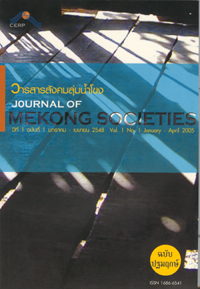Women and clan politics in the Vietnamese courts during Ly and Tran dynasties (A.D. 1010-1400)
Main Article Content
Abstract
This article will study the roles of women in the Vietnamese court of Ly and Tran dynasties (A.D. 1010-1225) by using official annals as the main sources, in addition to other secondary sources. This study shows that women in the imperial court; empress, concubine and princess dowager, had taken part in court politics which dominated the fate of the dynasty. Historically speaking, women in Vietnam had never experienced any significantly terrible custom such as foot binding as in China even though to which Vietnam is culturally indebt. Vietnam had got heroines like Hai Ba Trung or Two sisters Trung; Trung Trac and Trung Nhi, who led Vietnamese people against the Chinese invaders in the first century. While it is widely recognizable that Vietnamese society is basically matrilineal, yet women in traditional Vietnam, like Chinese counterparts, had served as the key factor to maintain the continuity of male clan through marriage. Marriage in traditional Vietnam, as in China and East Asian countries, basically involved the expansion of male clan and its power over female clans. For the imperial clan, this clan policy was designated as the subjugation of the aristocratic clans. Since the early dynasties, Ngo, Dinh and Le, Vietnamese monarchs had engaged with Chinese system implanted in their land. Among the institutional and cultural change, it was the tradition of family, which was considered as a very crucial base of the political stability of the regime according to the Confucian way. Thus it was evident that this transformation caused the severe problems at the court. The conflict related to the family rectification, was the marriage of the emperor. The early monarchs always ignored the Chinese tradition of family. Apparently, family affair was grave for those rulers. They often designated many empresses, while an emperor took a wife of former ruler as his wife. This conduct evidently affected the political situation of the times, which brought an end to the dynasties. The Ly dynasty, which ruled from the 11st to 13th centuries, had an attempt to strengthen the country by imitations of Chinese political and institutional forms. The reordering of imperial family was also an anxious aspect. Now the imperial marriage was the tool of controlling the aristocratic clans surrounding the imperial capital. It was expected and designated to reinforce the dynasty. But it was apparent that some Ly monarchs ignored the family regulation. They still nominated many empresses. A concubine who was the real mother of an emperor manipulated the throne and eventually conveyed the purge of former empress and number of female courtiers. The early emperors of the Tran dynasty had stabilized their power. They tried so hard to avoid the previous difficulties which destroyed Ly dynasty. This main concern led them to practice the incest. They married princesses of the Tran clan as they expected to integrate their clan members while pacifying the provincial aristocratic clans. However the practice had eventually been broken as imperial relatives severely fought with each other to discern the emperorûs favor. They wanted their daughters; concubines, to be promoted for being empress. The struggle eventually led to bloody conflict and weakened the whole dynasty. The situation began to deteriorate. A former empress or later the mother dowager became very influential in enthronement of the emperor but eventually caused the disaster to the court and imperial clan. Later emperors had even gone further by marrying women of other clan and had their sons became emperors. Ultimately, the Ho clan of the empress could topple the imperial Tran clan and brought about an end to the Tran dynasty.


